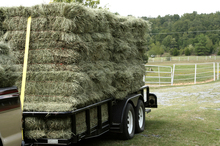Last yearâs hay is nearly gone from your hay lofts. The farmers have been busy growing and harvesting their hay crops, and fresh, new bales have just arrived at your farm.

Making the switch to new hay for your horse
Use that new hay in your loft, but be sure to check that it is dry and be careful in transitioning your horse to the extra protein and nutrients in it, and while youâre at it, enjoy the heady aroma of fresh hay.
It should be a beautiful sight, right? Those bright green bales riding up the bale elevator to be stacked in your loft, ready to be greedily consumed by your horses.
Yet some people have concerns about fresh, new hay. Will the horses colic or founder from the fresh hay? Weâve all been warned against feeding grass clippings to horses, or hay thatâs just been mown. So isnât new hay dangerous too? Shouldnât it sit for a while before feeding?
The answer is, not if itâs been properly cured. To check that new hay in your loft, simply open a bale and take a look at it, smell it, and feel it. If it is dry, and smells good, youâre fine. Dry hay is fine; if it wasnât dry, it should not have been baled. So if it is wet, and/or smells musty, it has not been properly cured and is not safe to feed.
If the hay has been treated with a preservative, it will not have that sweet smell, rather it smells a bit like vinegar. In this case just make sure it is dry and has no mold and you will be all right.
Another thing for you to keep in mind is that it is important to properly transition your horses to the new hay. New hay is full of protein and nutrients. Mix a little of it in at a time with your old hay and gradually replace the old hay with the new. This way you can slowly acclimate your horses to the new hay.
Feed less of the new hay because of the increased protein and nutrients. Itâs similar to having your horses on grass hay and switching them to alfalfa. You wouldnât just take away the timothy and throw alfalfa at them. You would switch gradually to allow their systems to adjust.
This extra protein and nutrients could be one of the reasons that some horsemen got nervous about new hay. Their horses might have had extra energy or reacted adversely to a sudden switch. But itâs not the hay (again, if it is properly cured), it is the process of adjustment.
So feel free to use that new hay in your loft. Just be sure to check that it is dry, and feed it according to the parameters suggested above. And while youâre at it, enjoy the heady aroma of fresh hay.
Brought to you by Hay Loft at Eastern Hay www.easternhay.com.
